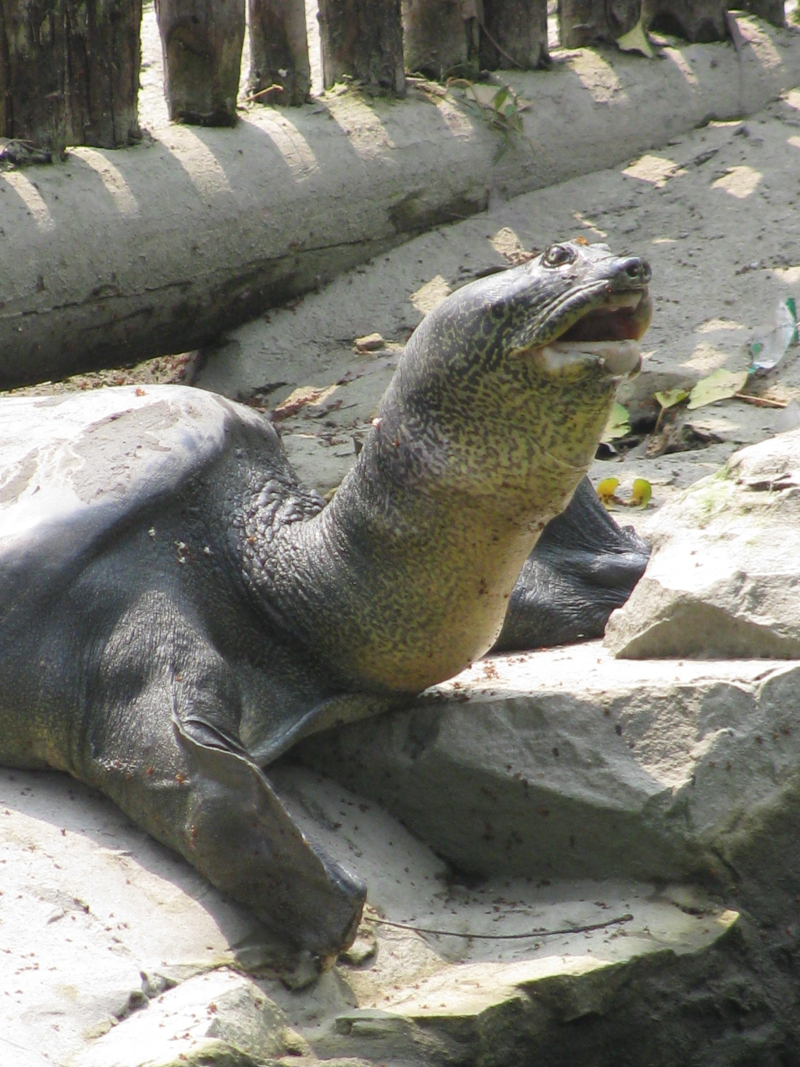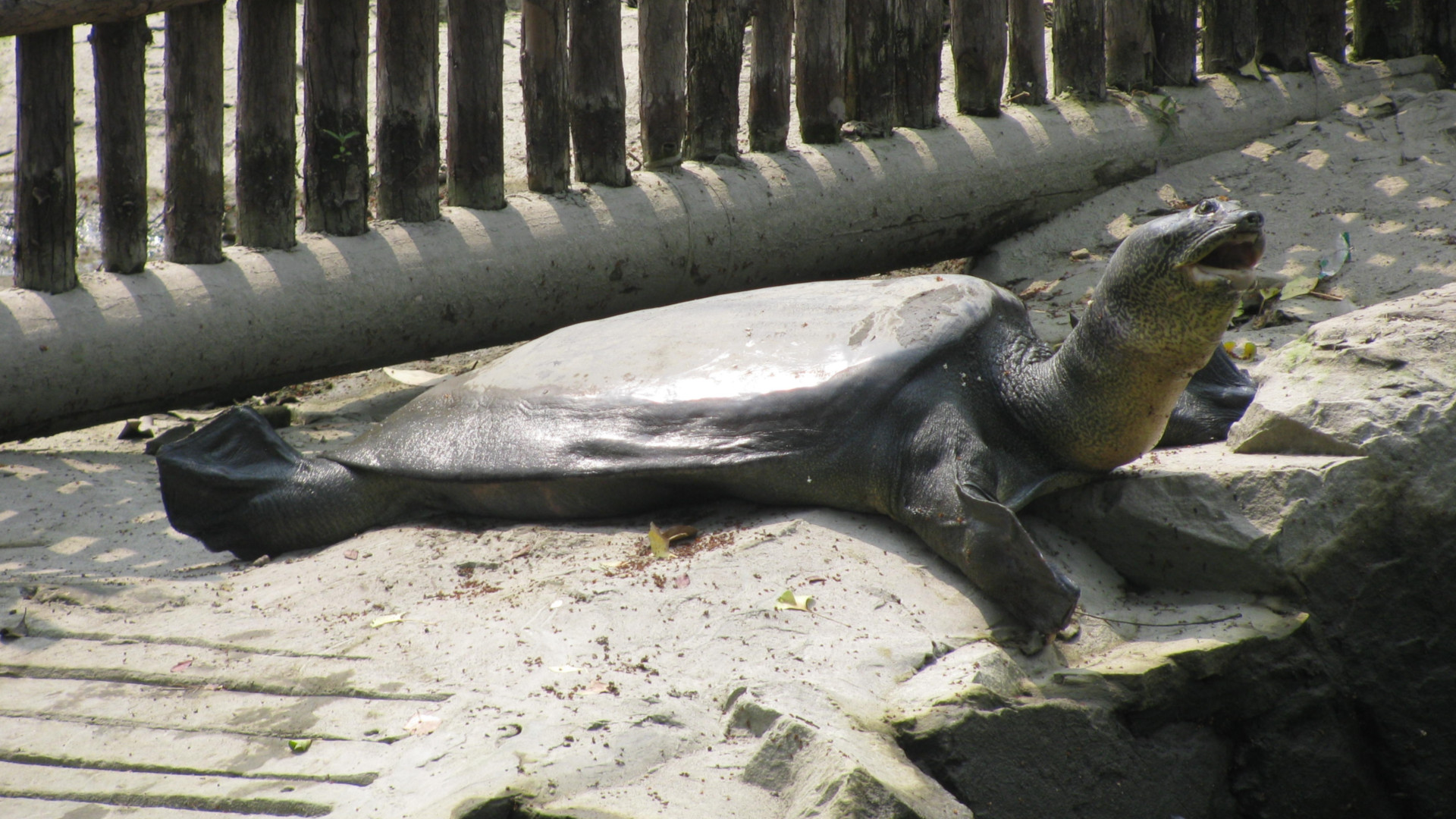The last known female Yangtze giant softshell turtle (Rafetus swinhoei) died over the weekend, pushing the world’s most endangered turtle species one step closer to extinction.
Known by her keepers at China’s Suzhou Zoo as Xiangxiang, the nine-decade-old turtle died unexpectedly on April 13 after an artificial insemination procedure, the fifth such attempt to help the animal produce offspring with Susu, the zoo’s 110-year-old male. The procedure reportedly went well, and Xiangxiang was in good health before it began, so the cause of her death is not yet known. A necropsy has been planned, and her ovarian tissue has already been collected and saved.
Her passing leaves the species with just three known individuals: Susu and two wild turtles that each live in separate lakes in Vietnam. The sex of those two wild turtles, one of which was just discovered a year ago, is not yet known.
The news of Xiangxiang death was “like being kicked in the gut,” says Rick Hudson, president of the Turtle Survival Alliance. “It’s a sad, tragic day. We’d really invested so much in that female over the years and had assembled the best repro team in the world to work with her. I can’t imagine what the team that was there went through this weekend. They tried for 12 hours to revive her.”

Xiangxiang and Susu, who lived at Suzhou Zoo for many years, had attempted mating on their own but never produced any fertilized eggs. Attempts to artificially inseminate Xiangxiang and hopefully save the species from extinction began in 2015. That’s when researchers realized that Susu’s penis had been mangled, probably decades earlier in a fight with another male (back when there were other males to fight). The damage wasn’t severe enough to prevent mating, but it was enough to block insemination.
Getting semen from the male and inseminating the female was never an easy task.
“Male softshell turtles have one of the most complex reproductive organs we know of,” Hudson told me in 2015. “It’s a bizarre-looking appendage with multiple tentacles and it’s just a huge, horrible looking thing. It’s that way for a reason. All of those appendages and things that come off them must fit inside the female softshell turtle’s anatomy somehow.”
At the time, they didn’t know exactly how those male and female sex organs worked together. They’ve learned a lot since then by examining other softshell turtle species. Hudson says the reproductive team had just finished working with a non-endangered species of giant softshell at Singapore Zoo “and had really perfected their artificial insemination technique.”
Meanwhile, they’d also improved their techniques for extracting semen from the male and “we had just gotten our best semen sample ever,” Hudson reports.
Getting that semen in place isn’t as easy as one-two-three. “The insemination procedure took about three hours of carefully directing that semen directly into the oviduct,” he says. “We thought we had our best chance ever of success.”
Anesthetizing and artificially inseminating an animal is always risky, but Hudson says “we didn’t have any choice.” With the two captive animals unable to reproduce naturally, artificial techniques were the last and best hope of saving the species . If they’d succeeded, the female could have laid dozens of eggs and the species could have been back on track to eventual recovery. Tragically, this time it did not work out.
Hudson praises the international team of collaborative organizations and researchers who have put so much work into trying to save this species, including the Wildlife Conservation Society and the Turtle Survival Alliance’s reproductive expert, Gerald Kuchling.
“To have the fortitude and the willingness to seek out these new solutions, knowing the risk and putting yourselves in a position open for criticism…these guys are my heroes,” he says.
Now the last glimmer of hope for this species lies not at Suzhou Zoo but in the lakes of Vietnam. The first step: figuring out if these last two wild individuals are male or female.
“We’re going to try to trap one of the animals and sex it and put a radio transmitter on it so we can back and find it later,” Hudson reports. “If that’s successful, we’ll try to trap the other animal in the other lake and determine what sex it is. The Vietnamese government is calling the shots on this and we’re playing a supporting role.”
What happens if the two turtles in Vietnam end up being a male and female? “Optimally I’d like to see those two animals set up in a nice, natural lake captive-breeding situation where we could build a nesting beach and know we could find the eggs. But it’s all speculative at this point because we don’t know the sex yet.”
Right now the team needs to recover from the death of Xiangxiang.
“It’s very emotional because you put that much blood, sweat and tears into something and then have this happen,” Hudson says. “It’s really demoralizing. But we’ll persevere.”
![]()



1 thought on “The Last Known Female Yangtze Giant Turtle Has Died — What Happens Next?”
Comments are closed.